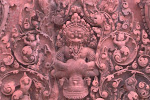| Jasmine season yields its offerings | | |
| Written by Stephanie Mee | |
| Thursday, 25 June 2009 The Phnom Penh Post | |
| A skip and jump from Phnom Penh, Kroh Kroubey village is famous for its jasmine farms, of which the fragrant and cream-coloured buds are often used to create offerings to Buddha Photo by: Stephanie Mee Sun Sey harvesting jasmine. "Right now is the best season to collect the jasmine flowers, as the water from the daily rains helps the plants produce many buds and flowers," said Nuon Chenda, the owner of a jasmine farm in Koh Kroubey village, an area renowned in Cambodia for its bountiful jasmine farms. With help from a team of local village girls, Nuon Chenda harvests the whitish-green buds of the jasmine early every morning before the flower can bloom, and sells the fragrant buds to wholesalers, who in turn transport the produce to Phnom Penh to be sold at various markets. Eleven-year old Sun Sey, who works on the farm, says that she can usually pick 1 or 2 kilograms of the flowers per day, taking her around three hours. "I get paid 3,000 riels (US$0.75) per kilogramme. Sometimes people come here to buy directly from us, but more often, the buds are sold to a large buyer," Sun Sey said. Nuon Chenda in turn sells the buds at $1 a kilogramme, although prices vary depending on the season. "Right now, because the bushes are flowering so well, the price for jasmine is low, but during the cold season (December to February) the plants don't produce as many flowers, so the price jumps to $25 a kilogramme," she said. On a busy day, such as a Buddhist holiday, Nuon Chenda can sell up to seven kilogrammes of jasmine buds a day, although her average yield is usually around four kilos. Decorative ornaments and offerings In Cambodia, jasmine buds are predominantly used to create offerings to Buddha, due to their heavenly fragrance and creamy white colour. In fact, the English word for jasmine comes from the Persian word yasmin, meaning "a gift from the gods". Buds and flowers are also used in decorative ornaments for temples, festivals, birthday parties and weddings, and the blossoms can be added to holy water used for blessings by the monks or boiled in water to make an aromatic jasmine tea. Taking a break from jasmine picking, Sun Sey demonstrated her skills in creating sweet-smelling offerings for the temple. "There are two main types of jasmine offerings," she said as her nimble fingers deftly threaded small buds onto a long wooden needle made from coconut branches. "Je kah is a thin stick with layers of buds circling it, usually with a purple or red flower on the end of it, and pum melei is the circular garland, which many people put around the neck of a Buddha or Shiva statue." Villagers in Koh Kroubey have a long tradition of growing jasmine, and farming methods and ornamentation techniques here have been passed down from generation to generation. Although the harvests may not be as abundant or lucrative as rice, jasmine is a year-round crop, and requires little maintenance once the trees have grown for two years. Sophea Sophat, a local jasmine farmer and mother of three, explains that the jasmine trees in Koh Kroubey are hardy plants, requiring no harsh pesticides, merely a simple fertiliser of vegetable compost. Trees are cut back after three to four years in order to encourage the growth of young, delicate buds and blossoms. As for the money, Sophea Sophat explained, "I'm not getting rich, but it's enough to put money in the pot for my family and food in our mouths". "I can't imagine doing anything else or not waking up to the lovely scent of fresh jasmine in the morning," Sophea Sophat added. Koh Kroubey can be reached from Phnom Penh by crossing the new Monivong bridge towards Kien Svay and taking the first right onto Street 369, and then a left at the large stone temple gates. The best time to go is in the morning when the jasmine buds are fresh, and farmers will custom-make temple offerings and flower arrangements on-site. |



